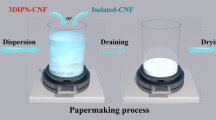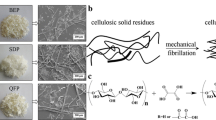Abstract
Noble metal nanoparticles (MNPs) and proper structural supporting materials can be fabricated into a sheet like catalytic composite, which is called dip-catalyst. Dip-catalyst is accentuated by its highly convenient deployment, easy separation and great recyclability. Polymeric film- or paper-based dip-catalyis has problems of low catalytic efficiency and MNP leaching or aggregation. Bacterial cellulose (BC) with its naturally nano-porous surface structure can efficiently support and stabilize the MNPs. Further compositing with plant fibers, the economy, catalytic efficiency and mechanical stiffness of the dip-catalyst may be greatly improved. However, the aqueous phase recyclability of the cellulosic fiber-based dip-catalyst is still limited, impairing its broad application. In this study, polyethylenimine (PEI) was used to crosslink BC-fiber and fiber–fiber within the BC-fiber matrix to improve the wet strength of the dip-catalyst. In detail, plant fibers were composited with the Au NP-embedded BC to fabricate a dip-catalyst through the paper handsheet making method. During the process, PEI was added as a wet-strength agent. The catalytic activity of this dip-catalyst was evaluated on the reduction of 4-nitrophenol in water by using NaBH4. Adding 1% PEI reduced the turnover frequency of 10% Au-BC sheet from 131.9 to 53.7 h−1, but greatly improved its recyclability and reusability. After reused for 30 times, reaction rate and yield was well maintained without impaired for the Au-BC catalytic sheets with PEI additions. This study promotes much broader applications for the BC-fiber dip-catalyst in chemical reactions.
Graphical abstract











Similar content being viewed by others
References
Chang YC, Chen DH (2009) Catalytic reduction of 4-nitrophenol by magnetically recoverable Au nanocatalyst. J Hazard Mater 165:664–669
Chen M, Kang H, Gong Y, Guo J, Zhang H, Liu R (2015) Bacterial cellulose supported gold nanoparticles with excellent catalytic properties. ACS Appl Mater Interfaces 7:21717–21726
Chen Y, Chen S, Wang B, Yao J, Wang H (2017) TEMPO-oxidized bacterial cellulose nanofibers-supported gold nanoparticles with superior catalytic properties. Carbohydr Polym 160:34–42
Faria VW, Oliveira DGM, Kurz MHS, Gonçalves FF, Scheeren CW, Rosa GR (2014) Palladium nanoparticles supported in a polymeric membrane: an efficient phosphine-free “green” catalyst for Suzuki-Miyaura reactions in water. RSC Adv 4:13446–13452
Gabaldon JP, Bore M, Datye AK (2007) Mesoporous silica supports for improved thermal stability in supported Au catalysts. Top Catal 44:253–262
Hariprasad E, Radhakrishnan TP (2010) A highly efficient and extensively reusable “dip catalyst” based on a silver-nanoparticle-embedded polymer thin film. Chem Eur J 16:14378–14384
Hariprasad E, Radhakrishnan TP (2012) Palladium nanoparticle-embedded polymer thin film “dip catalyst” for suzuki-miyaura reaction. ACS Catal 2:1179–1186
Jin X, Xiang Z, Liu Q, Chen Y, Lu F (2017) Polyethyleneimine-bacterial cellulose bioadsorbent for effective removal of copper and lead ions from aqueous solution. Bioresour Technol 244:844–849
Kamal T, Khan SB, Asiri AM (2016) Nickel nanoparticles-chitosan composite coated cellulose filter paper: an efficient and easily recoverable dip-catalyst for pollutants degradation. Environ Pollut 218:625–633
Kaushik M, Friedman HM, Bateman M, Moores A (2015) Cellulose nanocrystals as non-innocent supports for the synthesis of ruthenium nanoparticles and their application to arene hydrogenation. RSC Adv 5:53207–53210
Koga H, Tokunaga E, Hidaka M, Umemura Y, Saito T, Isogai A, Kitaoka T (2010) Topochemical synthesis and catalysis of metal nanoparticles exposed on crystalline cellulose nanofibers. Chem Commun 46:8567–8569
Kuroda K, Ishida T, Haruta M (2009) Reduction of 4-nitrophenol to 4-aminophenol over Au nanoparticles deposited on PMMA. J Mol Catal A: Chem 298:7–11
Lai X, Song Y, Liu M (2013) Preparation and application of cationic blocked waterborne polyurethane as paper strength agent. J Polym Res 20:1–6
Lam E, Hrapovic S, Majid E, Chong JH, Luong JHT (2012) Catalysis using gold nanoparticles decorated on nanocrystalline cellulose. Nanoscale 4:997–1002
Li W, Liu R, Kang H, Sun Y, Dong F, Huang Y (2013) Synthesis of amidoxime functionalized cellulose derivatives as a reducing agent and stabilizer for preparing gold nanoparticles. Polym Chem 4:2556
Molnar A, Papp A (2014) The use of polysaccharides and derivatives in palladium-catalyzed coupling reactions. Catal Sci Technol 4:295–310
Oliveira DGM, Alvarenga G, Scheeren CW, Rosa GR (2014) Development of reactor-type “dip catalyst” for transition metal nanoparticle-embedded polymer thin films. Quím Nova 37:1401–1403
Orden MUDL, Matías MC, Urreaga JM (2004) Spectroscopic study of the modification of cellulose with polyethylenimines. J Appl Polym Sci 92:2196–2202
Sharma V, Bahuguna A, Krishnan V (2017) Bioinspired dip catalysts for suzuki-miyaura cross-coupling reactions: effect of scaffold architecture on the performance of the catalyst. Adv Mater Interfaces 4:1700604
Wang HS, Yang LM, Liu YF, Mou KW, Li YZ, Cha RT (2016) Cationized melamine-formaldehyde resin for improving the wet strength of paper. Paper Biomater 1:56–62
Wu X, Lu C, Zhou Z, Yuan G, Xiong R, Zhang X (2014) Green synthesis and formation mechanism of cellulose nanocrystal-supported gold nanoparticles with enhanced catalytic performance. Environ Sci Nano 1:71–79
Xiang Z, Liu Q, Chen Y, Lu F (2017a) Effects of physical and chemical structures of bacterial cellulose on its enhancement to paper physical properties. Cellulose 24:3513–3523
Xiang Z, Jin X, Liu Q, Chen Y, Li J, Lu F (2017b) The reinforcement mechanism of bacterial cellulose on paper made from woody and non-woody fiber sources. Cellulose 24:5147–5156
Xiang Z, Chen Y, Liu Q, Lu F (2018) A highly recyclable dip-catalyst produced from palladium nanoparticle-embedded bacterial cellulose and plant fibers. Green Chem 20:1085–1094
Xiang Z, Zhang J, Liu Q, Chen Y, Li J, Lu F (2019) Improved dispersion of bacterial cellulose fibers for the reinforcement of paper made from recycled fibers. Nanomaterials 9:58
Xu GG, Yang CQ, Den Y (2006) Mechanism of paper wet strength development by polycarboxylic acids with different molecular weight and glutaraldehyde/poly(vinyl alcohol). J Appl Polym Sci 101:277–284
Yang JZ, Yu JW, Fan J, Sun DP, Tang WH, Yang XJ (2011) Biotemplated preparation of CdS nanoparticles/bacterial cellulose hybrid nanofibers for photocatalysis application. J Hazard Mater 189:377–383
Yang Y, Chen Z, Wu X, Zhang X, Yuan G (2018) Nanoporous cellulose membrane doped with silver for continuous catalytic decolorization of organic dyes. Cellulose 25:1–12
Zheng GC, Polavarapu L, Liz-Marzan LM, Pastoriza-Santos I, Perez-Juste J (2015) Gold nanoparticle-loaded filter paper: a recyclable dip-catalyst for real-time reaction monitoring by surface enhanced Raman scattering. Chem Commun 51:4572–4575
Zhou PP, Wang HH, Yang JZ, Tang J, Sun DP, Tang WH (2012) Bacteria cellulose nanofibers supported palladium(0) nanocomposite and its catalysis evaluation in heck reaction. Ind Eng Chem Res 51:5743–5748
Zhou ZH, Lu CH, Wu XD, Zhang XX (2013) Cellulose nanocrystals as a novel support for CuO nanoparticles catalysts: facile synthesis and their application to 4-nitrophenol reduction. RSC Adv 3:26066–26073
Acknowledgments
This work was supported by the National Natural Science Foundation of China (31600470), Guangzhou Science and Technology Program (Key Scientific Research Project 201707020011), Guangzhou Science and Technology Program (General Scientific Research Project 201707010053), and Guangdong Province Science Foundation for Cultivating National Engineering Research Center for Efficient Utilization of Plant Fibers (2017B090903003). The authors would also like to thank Nanjing High Tech University Biological Technology Research Institute Co., Ltd. for providing the bacterial cellulose.
Author information
Authors and Affiliations
Corresponding author
Additional information
Publisher's Note
Springer Nature remains neutral with regard to jurisdictional claims in published maps and institutional affiliations.
Rights and permissions
About this article
Cite this article
Wu, X., Xiang, Z., Song, T. et al. Wet-strength agent improves recyclability of dip-catalyst fabricated from gold nanoparticle-embedded bacterial cellulose and plant fibers. Cellulose 26, 3375–3386 (2019). https://doi.org/10.1007/s10570-019-02297-0
Received:
Accepted:
Published:
Issue Date:
DOI: https://doi.org/10.1007/s10570-019-02297-0




